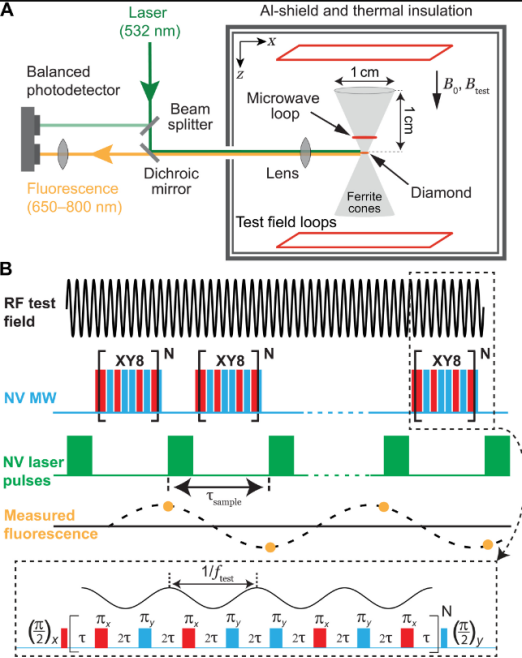Company tel:+86-379-63184520
Contact number:+86-15937921751
Postcode:471000
Email:info@yuxindiamond.com
Address:3-1-508 Luoyang National University Science Park, No. 2 Penglai Road, Jianxi District, Luoyang, China 471000
Nuclear quadrupole resonance spectroscopy with a femtotesla diamond magnetometer
Radio frequency (RF) magnetometers based on nitrogen vacancy centers in diamond are predicted to offer femtotesla sensitivity, but previous experiments were limited to the picotesla level. We demonstrate a femtotesla RF magnetometer using a diamond membrane inserted between ferrite flux concentrators. The device provides ~300-fold amplitude enhancement for RF magnetic fields from 70 kHz to 3.6 MHz, and the sensitivity reaches ~70 fT√s at 0.35 MHz. The sensor detected the 3.6-MHz nuclear quadrupole resonance (NQR) of room-temperature sodium nitrite powder. The sensor’s recovery time after an RF pulse is ~35 μs, limited by the excitation coil’s ring-down time. The sodium-nitrite NQR frequency shifts with temperature as −1.00±0.02 kHz/K, the magnetization dephasing time is T2*=887±51 μs, and multipulse sequences extend the signal lifetime to 332±23 ms, all consistent with coil-based studies. Our results expand the sensitivity frontier of diamond magnetometers to the femtotesla range, with potential applications in security, medical imaging, and materials science.
INTRODUCTION
Magnetometers based on negatively charged nitrogen vacancy (NV) centers in diamond are promising room-temperature sensors for detecting magnetic phenomena across a wide range of frequencies. Over the past decade, various sensing protocols and fabrication methods have been developed to improve the sensitivity of diamond magnetometers in the sub–10-kHz, radio frequency (RF), and microwave (MW)frequency ranges. However, the best reported sensitivities, ∼1 pT s1/2 , still trail the achievable levels in magnetometers based on alkali-metal vapor and superconducting quantum interference devices.
Recently, magnetic flux concentrators have been used to improve the performance of diamond magnetometers, and a sub-picotesla sensitivity has been realized for low frequencies (≲1 kHz) by inserting an NV-doped diamond membrane between two ferrite cones. We hypothesized that the same approach can be used for improving the sensitivity in the RF range (kilohertz to megahertz) if the flux concentrator’s magnetic properties do not degrade at such frequencies. In fact, better sensitivity may be expected in the RF range because the diamond RF magnetometer can operate in a pulsed regime where the NV spin coherence time is substantially longer.
A diamond RF magnetometer with femtotesla sensitivity may find immediate application as a noninductive detector for nuclear quadrupole resonance (NQR) spectroscopy. NQR spectroscopy is a solid-state analysis technique that provides a unique chemical fingerprint based on the coupling of nuclear quadrupole moments to their local electric field gradients. NQR spectroscopy is used to identify powder substances in ambient conditions for security and pharmaceutical applications and to study the temperature-dependent properties of single-crystal materials. These applications typically require the ability to detect kilohertz to megahertz frequencies, at low-bias magnetic fields ≲1 mT, with femtotesla sensitivity. Previously, NV centers were used to detect NQR signals arising from nanoscale statistical polarization in single-crystal boron nitride layers in direct contact with the diamond. However, using NV centers to remotely detect powders remains an open challenge due to the need for high sensitivity.
Here, we demonstrate a frequency-tunable diamond RF magnetometer with a sensitivity of ∼70 fT s1/2 at 0.35 MHz, using ferrite flux concentrators (3) and a multipulse synchronized readout scheme. The sensitivity remains within a factor of three of this value for the frequency range of 0.07 to 3.6 MHz. We used the magnetometer to detect the 3.6-MHz NQR signal of 14N in sodium nitrite powder samples. Our work expands the sensitivity frontier of diamond magnetometry to the femtotesla range and introduces a new method for remote detection of solid-state magnetic resonance.
RESULTS
A schematic of the diamond RF magnetometer is shown in Fig. 1A. The apparatus is similar to one previously used for low-frequency magnetometry, with modifications (Materials and Methods and section S1) made for RF magnetometry and NQR spectroscopy.

DISCUSSION
While this work realizes several benchmarks in the development of diamond quantum sensors, the present implementation of RF magnetometry and NQR detection operates far from fundamental limits.
Source:science.org DOI: 10.1126/sciadv.adh3189







